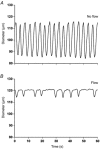Inhibition of the active lymph pump by flow in rat mesenteric lymphatics and thoracic duct
- PMID: 11986387
- PMCID: PMC2290276
- DOI: 10.1113/jphysiol.2001.016642
Inhibition of the active lymph pump by flow in rat mesenteric lymphatics and thoracic duct
Abstract
There are only a few reports of the influence of imposed flow on an active lymph pump under conditions of controlled intraluminal pressure. Thus, the mechanisms are not clearly defined. Rat mesenteric lymphatics and thoracic ducts were isolated, cannulated and pressurized. Input and output pressures were adjusted to impose various flows. Lymphatic systolic and diastolic diameters were measured and used to determine contraction frequency and pump flow indices. Imposed flow inhibited the active lymph pump in both mesenteric lymphatics and in the thoracic duct. The active pump of the thoracic duct appeared more sensitive to flow than did the active pump of the mesenteric lymphatics. Imposed flow reduced the frequency and amplitude of the contractions and accordingly the active pump flow. Flow-induced inhibition of the active lymph pump followed two temporal patterns. The first pattern was a rapidly developing inhibition of contraction frequency. Upon imposition of flow, the contraction frequency immediately fell and then partially recovered over time during continued flow. This effect was dependent on the magnitude of imposed flow, but did not depend on the direction of flow. The effect also depended upon the rate of change in the direction of flow. The second pattern was a slowly developing reduction of the amplitude of the lymphatic contractions, which increased over time during continued flow. The inhibition of contraction amplitude was dependent on the direction of the imposed flow, but independent of the magnitude of flow. Nitric oxide was partly but not completely responsible for the influence of flow on the mesenteric lymph pump. Exposure to NO mimicked the effects of flow, and inhibition of the NO synthase by N (G)-monomethyl-L-arginine attenuated but did not completely abolish the effects of flow.
Figures






References
-
- Benoit JN, Zawieja DC, Goodman AH, Granger HJ. Characterization of intact mesenteric lymphatic pump and its responsiveness to acute edemagenic stress. American Journal of Physiology. 1989;257:H2059–2069. - PubMed
-
- Borisov AV. The theory of the design of the lymphangion. Morfologiia. 1997;112:7–17. (in Russian) - PubMed
-
- Duling BR, Gore RW, Dacey RG, Jr, Damon DN. Methods for isolation, cannulation, and in vitro study of single microvessels. American Journal of Physiology. 1981;241:H108–116. - PubMed
-
- Gashev AA. The pump function of the lymphangion and the effect on it of different hydrostatic conditions. Fiziologicheskii Zhurnal SSSR Imeni I. M. Sechenova. 1989;75:1737–1743. (in Russian) - PubMed
-
- Gashev AA. The mechanism of the formation of a reverse fluid filling in the lymphangions. Fiziologicheskii Zhurnal SSSR Imeni I. M. Sechenova. 1991;77:63–69. (in Russian) - PubMed
Publication types
MeSH terms
Grants and funding
LinkOut - more resources
Full Text Sources
Other Literature Sources

